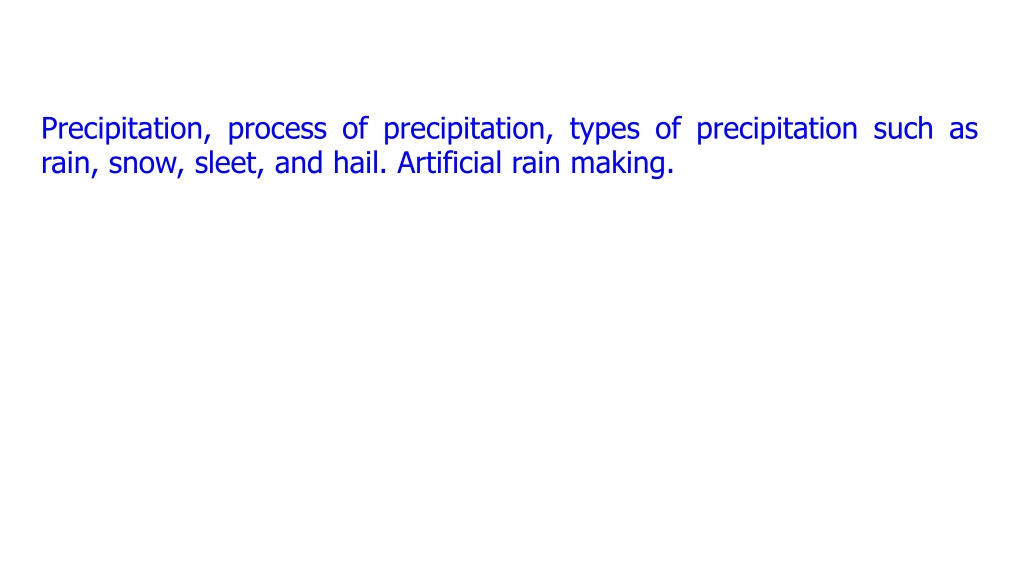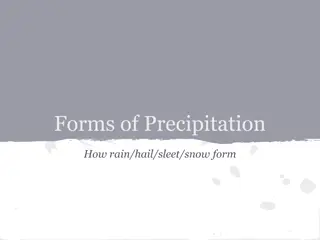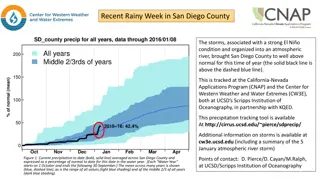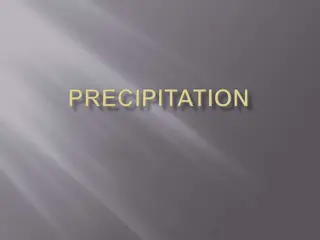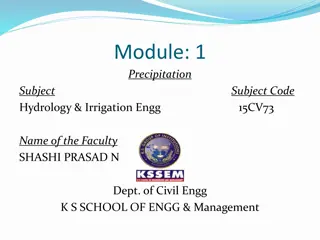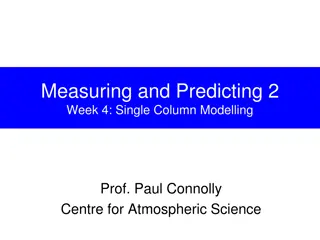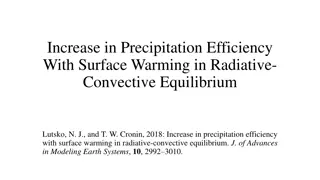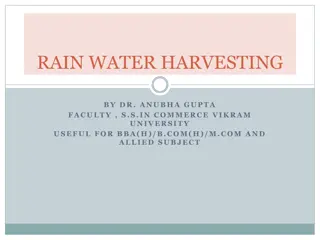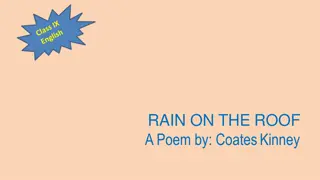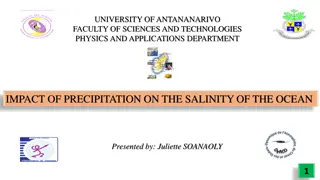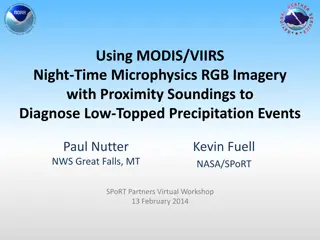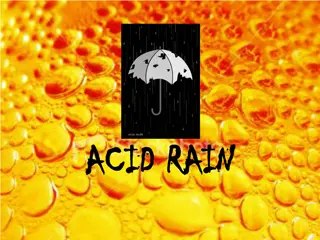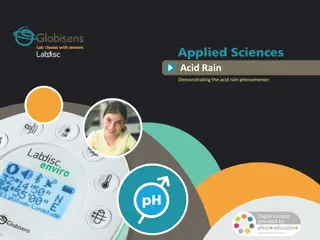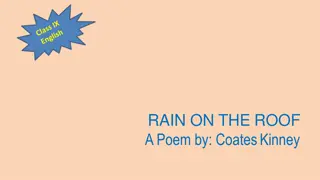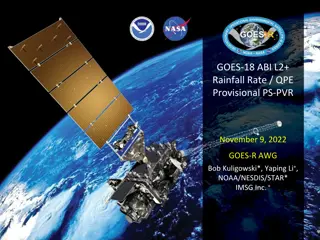Understanding Precipitation: Process, Types, and Artificial Rain Making
Precipitation occurs through the condensation of water vapors in the air. The process involves various types such as rain, snow, sleet, and hail, each formed differently - convectional, orographic, and frontal/cyclonic. Learn about the mechanisms behind precipitation, including the creation of artificial rain.
Uploaded on Sep 20, 2024 | 1 Views
Download Presentation

Please find below an Image/Link to download the presentation.
The content on the website is provided AS IS for your information and personal use only. It may not be sold, licensed, or shared on other websites without obtaining consent from the author. Download presentation by click this link. If you encounter any issues during the download, it is possible that the publisher has removed the file from their server.
E N D
Presentation Transcript
Precipitation, process of precipitation, types of precipitation such as rain, snow, sleet, and hail. Artificial rain making.
Process of Precipitation: Precipitation is caused by condensation of water vapours of the air mass. The ascending air mass with sufficient amount of water vapours becomes saturated due to adiabatic cooling. Condensation of water vapours leads to the formation of clouds. Every cloud contains updraft and downdraft. The development and height of the clouds depend upon the updraft. Stronger the updraft, greater is the height of the cloud. When the liquid water increases, the strength of the updraft decreases and downdraft starts increasing. As a result, precipitation is produced. Even though all clouds contain water, but some produce precipitation while others do not. In certain cases precipitated moisture falls from the clouds, but it gets evaporated from the atmosphere before reaching the earth surface.
Forms of Precipitation: a) Convectional, b) Orographic and c) Frontal or Cyclonic Convectional Precipitation results from the heating of the earth's surface. The warm ground heats the air over it. As the air warms, the air molecules begin to move further apart. With increased distance between molecules are less densely packed. Thus, the air becomes lighter and rises rapidly into the atmosphere. As the air rises, it cools. Water vapour in the air condenses into clouds and precipitation. molecules, the
Orographic Precipitation results when warm moist air moving across the ocean is forced to rise by large mountains. As the air rises, it cools. Cold air cannot hold as much moisture as warm air. As air cools, the water vapour in the air condenses, cloud forms and precipitation (rain or snow) occurs on the windward side of the mountain. The air is now dry and rises over top the mountain. As the air moves back down the mountain, it collects moisture from the ground via evaporation. This side of the mountain is called the leeward side. It receives very little precipitate.
Frontal or Cyclonic precipitation results when the leading edge of a warm, moist air mass (warm front) meets a cool and dry air mass (cold front). The molecules in the cold air are more tightly packed together (i.e., more dense), and thus, the cold air is heavier than the warm air. The warmer air mass is forced up over the cool air. As it rises, the warm air cools, the water vapour in the air condenses, and clouds and precipitation result. This precipitation is common in Atlantic Canada. This type of system is called Frontal Precipitation because the moisture tends to occur along the front of the air mass. A cyclonic storm is a large, low pressure system that forms when a warm air mass and a cold air mass collide. This collision often occurs under the polar- front jet stream which spreads cold, dry arctic air near warm, moist tropical air. The rotation of the earth causes the air to circulate in a counter clockwise direction around an area of low pressure.
Type of precipitation Rain is formed when the sun warms a body of water and the water begins to evaporate. Most of this evaporation comes from the oceans, although lakes and rivers also account for a portion of the water evaporated. The warmed water rises into the air as a virtually invisible vapor. Once the vapor reaches a certain level, it cools and begins to condense. This condensing causes the water vapor to turn first into clouds and then progresses into water. The vapor continues to collect and compress into its liquid form, eventually becoming too heavy for a cloud to contain the water anymore any more. When clouds reach this point, the water falls back to the earth as rain.
Snow is essentially rain that has cooled to the point where it forms into small water crystals. These water crystals form into snowflakes that fall to the earth just like rain does. Each snowflake has its own unique and different shape and size. Depending on a variety of factors such as location, climate, and other prevailing weather conditions among others, snowflakes will vary in the amount of water they contain.
Sleet is most uncommon of the four basic types of precipitation. Sleet is a combination of snow, rain, and ice. For sleet to form, it must go through a warm- up and cool-down phase (sometimes more than once) from the time it leaves the clouds to the time it hits the ground. It normally starts out as snow when it falls from the cloud, but hits a warmer air current that melt the snowflakes into a normal raindrops. However, before the water droplets hit the ground, the meet another colder air current which refreezes the droplets, turning many to ice pellets.
Hail is the most damaging form of precipitation. Hail if formed when a water droplet gets picked up by an air current and carried to a higher elevation where it freezes and condenses into pieces of ice. The resulting hail is too dense for the air to keep it afloat and it will then fall to the ground without melting. When hail is the only form of precipitation falling, it is referred to as a hailstorm
Rainfall Crop production relationship: The type, timing, and amount of precipitation received during the year play critical roles in crop productivity. Precipitation types include unfrozen (rain) and frozen (snow, sleet, and hail). Snow and sleet occur in the winter and hail in the warmer seasons. In the winter, frozen precipitation is less efficient than unfrozen in recharging the soil profile. The efficiency of rain in recharging the soil depends on the rate or intensity with which the rain falls. Rain showers or storms that fall at rates greater than 12.7 cm/hr) are less efficient than lighter showers because the water forms ponds on the surface and runs off the fields into ditches and rivers, carrying along precious topsoil.
The timing of precipitation is critical to crop growth. In the period from harvest to planting, referred to as the fallow season, recharge of the soil profile occurs. If the soil profile is not sufficiently recharged during the fallow season, the possibility of drought during the upcoming growing season increases because of a greater likelihood of a soil water deficit during critical crop growth stages.
Timing of precipitation. The timing of rainfall while crops are growing is critical. During seed germination and stand establishment, either too much or too little rain can influence yields. Too much rain, especially with low temperatures, can result in seed diseases, causing poor stands, or can saturate the soil, causing poor soil aeration and poor germination and stands. Dry soils during germination and stand establishment can result in either poor seed germination or weak and small plants that may not withstand dry weather during the early growth of the crop, causing smaller plant leaf area. During the rapid vegetative growth stage, too much rain can result in a smaller shoot-to-root ratio and the establishment of shallow roots. When this happens, the crop is more susceptible to dry spells.
Rainfall based crop production potential: Rain-fed agriculture is practiced on 80 % of the world s agricultural land area, and generates 65-70 % of the world s staple foods. The low and variable productivity of these lands is the major cause of poverty for 70 % of the world s poor inhabiting these lands. The distinct feature of rain-fed agriculture in these developing countries is that both productivity improvement and expansion has been slower relative to irrigated agriculture. However, there is a 100 % yield increase potential in rain-fed agriculture in the developing countries, compared to only 10 % for irrigated crops. This calls for increased efforts to upgrade rain-fed systems globally and, especially in developing countries to provide sufficient and affordable food and nutrition to the vast populations.
Cloud seeding is the process of spreading chemicals into the upper part of clouds to stimulate the precipitation process and form rain from clouds. The usual intent of cloud seeding is to increase precipitation (rain or snow), but hail and fog suppression are also widely practiced in airports.
Methodology: Chemicals used for cloud seeding are: i) Silver iodide, ii) dry ice, iii) Liquid propane, & iv) Table salt. Silver iodide has a crystalline structure similar to that of ice. Since most rainfall starts through the growth of ice crystals from super-cooled cloud droplets in the upper parts of clouds. Silver iodide particles encourage the growth of new ice particles, thus induced freezing nucleation. Dry ice or Liquid Propane, which expands into a gas and cools the air to such an extent that ice crystals can nucleate spontaneously from the water vapor. These agents can produce ice crystals at higher temperatures than silver iodide.
In 2010 an attempt was made where infrared lesser pulses were directed to the air. The pulses encouraged atmospheric sulfur dioxide and nitrogen dioxide to form particles that would act as seeds.
Static seeding: The saturated vapor pressure over ice is higher than over water. Due to this ice particles grow at the expense of liquid droplets. If sufficient growth takes place, the particles become heavy enough to fall as precipitation from clouds that otherwise would produce no precipitation. This process occurs in mid-latitude clouds and known as "static" seeding.
Dynamic seeding: Seeding of warm-season or tropical cumulonimbus (convective) clouds seeks to exploit the latent heat released by freezing. The additional latent heat adds buoyancy, strengthens updrafts, ensures more low- level convergence, and ultimately causes rapid growth of properly selected clouds.
Impact on environment and health With an NFPA 704 rating of Blue 2, silver iodide can cause temporary incapacitation or possible residual injury to humans and mammals. However, there have been several detailed ecological studies that showed negligible environmental and health impacts. Accumulations in the soil, vegetation, and surface runoff have not been large enough to measure above natural background.
Use in Asia : About 24 countries currently practice weather modification operationally. The largest cloud seeding system in the world is in People's Republic of China, which believes that it increases the amount of rain over several increasingly arid regions, including its capital city, Beijing, by firing silver iodide rockets into the sky where rain is desired. China used cloud seeding in Beijing just before the 2008 Olympic Games in order to clear the air of pollution. In February 2009, China also blasted iodide sticks over Beijing to artificially induce snowfall after four months of drought. The snowfall in Beijing lasted for approximately three days and led to the closure of 12 main roads around Beijing.
Cloud seeding in India In India, cloud seeding operations were conducted during the years 1983, 1984 87,1993-94 by Tamil Nadu Govt. due to severe drought. In the years 2003 and 2004 Karnataka government initiated cloud seeding. Cloud seeding operations was also conducted in the same year in the state of Maharashtra. In 2008, there are plans for 12 districts of state of Andhra Pradesh.
